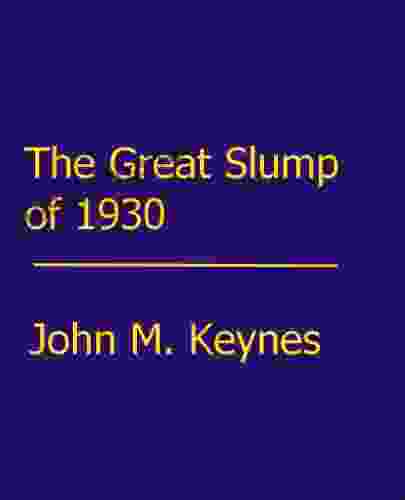The Great Slump of 1930: John Maynard Keynes and the Economic Crisis

The Great Slump of 1930, also known as the Great Depression, was one of the worst economic downturns in modern history. It began in the United States but quickly spread to other countries around the world. By the early 1930s, unemployment had reached unprecedented levels, and businesses were failing at an alarming rate.
In response to the crisis, governments and economists tried a variety of policies to stimulate economic growth. One of the most influential economists of the time was John Maynard Keynes. Keynes argued that the government should intervene in the economy to increase demand and create jobs. His ideas were controversial at the time, but they eventually became widely accepted and helped to lay the foundation for the modern welfare state.
The causes of the Great Slump are complex and still debated by economists today. However, some of the key factors that contributed to the crisis include:
4.4 out of 5
| Language | : | English |
| File size | : | 70 KB |
| Text-to-Speech | : | Enabled |
| Screen Reader | : | Supported |
| Enhanced typesetting | : | Enabled |
| Word Wise | : | Enabled |
| Print length | : | 14 pages |
| Lending | : | Enabled |
- The stock market crash of 1929. The stock market crash of 1929 was a major shock to the U.S. economy. It led to a loss of confidence in the stock market and a decline in investment.
- Overproduction. In the years leading up to the crash, businesses had been overproducing goods, which led to a buildup of unsold inventory. When the stock market crashed, consumers stopped buying goods, and businesses were left with large amounts of unsold inventory.
- Deflation. Falling prices made it difficult for businesses to make a profit. This led to a decline in investment and a further reduction in demand.
- The gold standard. The gold standard was a system of fixed exchange rates that prevented countries from devaluing their currencies. This made it difficult for countries to stimulate their economies through monetary policy.
The Great Slump had a devastating impact on the world economy. In the United States, unemployment reached 25% at the height of the crisis. In other countries, unemployment rates were even higher. The crisis also led to a sharp decline in output and investment.
The Great Slump had a profound impact on the social and political landscape of the world. The crisis led to the rise of fascism and communism in Europe. It also contributed to the outbreak of World War II.
In the midst of the Great Slump, John Maynard Keynes published his book "The General Theory of Employment, Interest, and Money." In this book, Keynes argued that the government should intervene in the economy to increase demand and create jobs.
Keynes's ideas were controversial at the time, but they eventually became widely accepted. Keynesian economics became the dominant economic theory in the postwar era, and it helped to lay the foundation for the modern welfare state.
Keynes's main ideas can be summarized as follows:
- Aggregate demand. The level of economic activity in an economy is determined by aggregate demand, which is the total spending in the economy.
- Multiplier effect. An increase in spending will lead to an increase in output and income in the economy.
- Government intervention. The government can use fiscal policy (taxation and spending) and monetary policy (interest rates) to increase aggregate demand.
Keynesian ideas were put into practice in the United States during the Great Depression. The government implemented a number of programs to increase spending, including public works projects and unemployment benefits. These programs helped to stimulate economic activity and reduce unemployment.
Keynesian economics was also used to help prevent another Great Depression after World War II. The Bretton Woods system of fixed exchange rates and capital controls helped to stabilize the world economy. The International Monetary Fund (IMF) and the World Bank were created to provide financial assistance to countries in need.
Keynesian economics has been the dominant economic theory for most of the postwar era. It has helped to prevent another Great Depression and has contributed to the growth of the global economy. However, Keynesian economics has also been criticized for its reliance on government intervention. Some economists argue that government intervention can lead to inflation and other problems.
Despite these criticisms, Keynesian economics remains an important part of the economic toolkit. It is a powerful tool that can be used to stimulate economic growth and reduce unemployment.
4.4 out of 5
| Language | : | English |
| File size | : | 70 KB |
| Text-to-Speech | : | Enabled |
| Screen Reader | : | Supported |
| Enhanced typesetting | : | Enabled |
| Word Wise | : | Enabled |
| Print length | : | 14 pages |
| Lending | : | Enabled |
Do you want to contribute by writing guest posts on this blog?
Please contact us and send us a resume of previous articles that you have written.
 Top Book
Top Book Novel
Novel Fiction
Fiction Nonfiction
Nonfiction Literature
Literature Paperback
Paperback Hardcover
Hardcover E-book
E-book Audiobook
Audiobook Bestseller
Bestseller Classic
Classic Mystery
Mystery Thriller
Thriller Romance
Romance Fantasy
Fantasy Science Fiction
Science Fiction Biography
Biography Memoir
Memoir Autobiography
Autobiography Poetry
Poetry Drama
Drama Historical Fiction
Historical Fiction Self-help
Self-help Young Adult
Young Adult Childrens Books
Childrens Books Graphic Novel
Graphic Novel Anthology
Anthology Series
Series Encyclopedia
Encyclopedia Reference
Reference Guidebook
Guidebook Textbook
Textbook Workbook
Workbook Journal
Journal Diary
Diary Manuscript
Manuscript Folio
Folio Pulp Fiction
Pulp Fiction Short Stories
Short Stories Fairy Tales
Fairy Tales Fables
Fables Mythology
Mythology Philosophy
Philosophy Religion
Religion Spirituality
Spirituality Essays
Essays Critique
Critique Commentary
Commentary Glossary
Glossary Bibliography
Bibliography Index
Index Table of Contents
Table of Contents Preface
Preface Introduction
Introduction Foreword
Foreword Afterword
Afterword Appendices
Appendices Annotations
Annotations Footnotes
Footnotes Epilogue
Epilogue Prologue
Prologue Rachel Harrison
Rachel Harrison Justin Fenton
Justin Fenton Peter Alkema
Peter Alkema William Boyle
William Boyle Dalai Lama
Dalai Lama William Manchester
William Manchester Paul Barron
Paul Barron Ken Shores
Ken Shores Eric Linklater
Eric Linklater Ted Riley
Ted Riley Ashley Audrain
Ashley Audrain Mac Walters
Mac Walters Marnie Heenan
Marnie Heenan Micheline Ryckman
Micheline Ryckman Archie Goodwin
Archie Goodwin Jayne Smith
Jayne Smith Aphra Behn
Aphra Behn P F Kluge
P F Kluge Debby Applegate
Debby Applegate I D Blind
I D Blind
Light bulbAdvertise smarter! Our strategic ad space ensures maximum exposure. Reserve your spot today!

 Benji PowellJohann Sebastian Bach's Cello Suite No. 1 Prelude: A Masterpiece of Baroque...
Benji PowellJohann Sebastian Bach's Cello Suite No. 1 Prelude: A Masterpiece of Baroque...
 DeShawn PowellPrepare to Be Captivated: An Unputdownable Scottish Detective Thriller by DCI...
DeShawn PowellPrepare to Be Captivated: An Unputdownable Scottish Detective Thriller by DCI...
 Harrison BlairExploring the Romantic Masterpiece: Violin Concerto in D Major, Op. 35 by...
Harrison BlairExploring the Romantic Masterpiece: Violin Concerto in D Major, Op. 35 by...
 Leslie CarterThe Enigmatic Lady in the Red Dress: Unveiling the Mystery Behind a Timeless...
Leslie CarterThe Enigmatic Lady in the Red Dress: Unveiling the Mystery Behind a Timeless... Hank MitchellFollow ·8.8k
Hank MitchellFollow ·8.8k Owen SimmonsFollow ·8.6k
Owen SimmonsFollow ·8.6k Angelo WardFollow ·4k
Angelo WardFollow ·4k Diego BlairFollow ·12.4k
Diego BlairFollow ·12.4k F. Scott FitzgeraldFollow ·6.5k
F. Scott FitzgeraldFollow ·6.5k Devon MitchellFollow ·12.6k
Devon MitchellFollow ·12.6k Cason CoxFollow ·13.2k
Cason CoxFollow ·13.2k Cristian CoxFollow ·2.3k
Cristian CoxFollow ·2.3k

 Bryan Gray
Bryan GrayCello Alternativo: Exploring Contemporary Pizzicato...
: Embracing the Avant-Garde Within...

 Victor Hugo
Victor HugoThe Social Revolution: Barry Libert's Vision for a More...
In a world where...

 Tony Carter
Tony CarterA Comprehensive Guide to Crafting Clear and Effective Job...
A job description is a critical tool...

 Deacon Bell
Deacon BellSelected Poems And Prose Lorenzo Da Ponte Italian Library
Lorenzo Da Ponte, born...

 Francisco Cox
Francisco CoxWhat You Need To Know About Opportunity Cost: A...
Opportunity cost is a fundamental concept...

 Bill Grant
Bill GrantWhy Our Kids With Behavioral Challenges Are Falling...
Every year,...
4.4 out of 5
| Language | : | English |
| File size | : | 70 KB |
| Text-to-Speech | : | Enabled |
| Screen Reader | : | Supported |
| Enhanced typesetting | : | Enabled |
| Word Wise | : | Enabled |
| Print length | : | 14 pages |
| Lending | : | Enabled |




